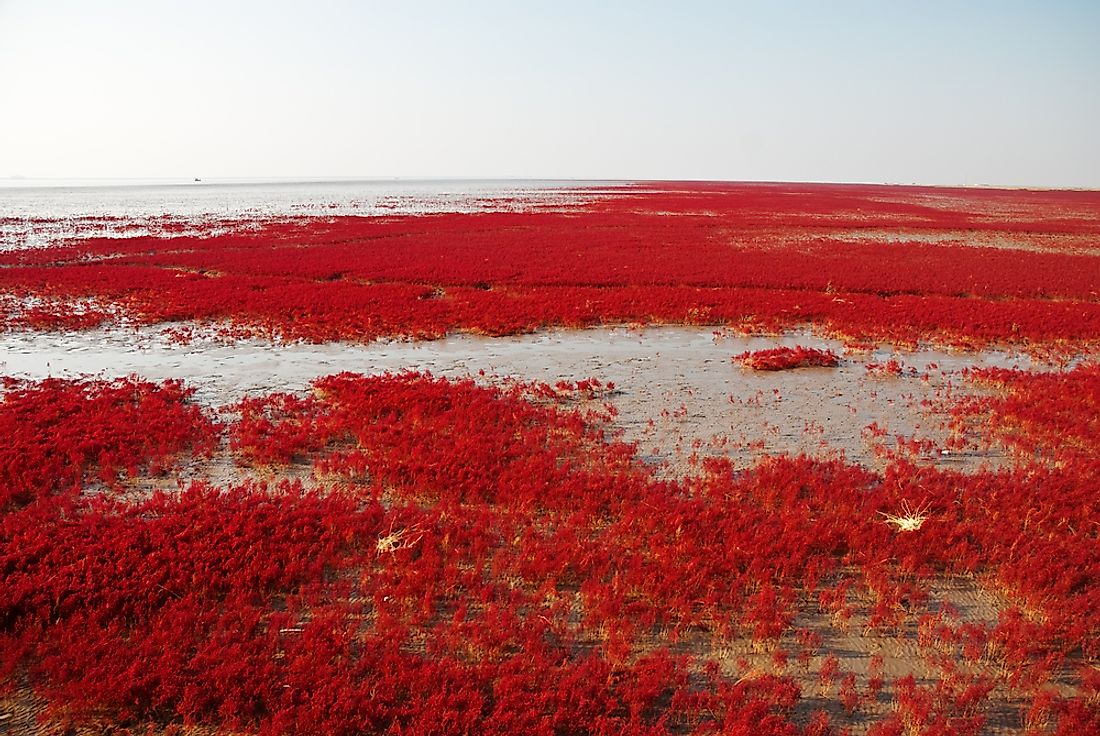Panjin Red Beach, China – Unique Places In The World

Panjin Red Beach is not a sandy beach. Instead, it is a reed-covered wetland in one of the world’s largest reed marsh areas, the Liaohe River Delta. Its colorful, though misleading, name refers to the striking seasonal hues of its coastline, which is covered with the plant seepweed (suaeda salsa). The Red Beach is located in Dawa County, about 18 miles southwest of Panjin City, in the northeast province of Liaoning, China.
4. Tourism
Since the 1984 inception of Panjin City, the Red Beach has been developed as an eco-tourist destination. This state-protected nature reserve includes a single space for the public, a 6,500-foot wooden jetty, which enables non-invasive views of its beautiful scenery. The first step en route to the Red Beach is Panjin City, which is accessible within China via train or bus. Nearby airports include Shenyang TaoXian International, Dalian ZhouShuiZi International, and JinZhou XiaoLingZi. Several companies in Panjin offer tours that include bus transportation as well. There is also a mini-bus from Panjin City to the Red Beach Resort, from which one can catch a tuk-tuk, taxi, or mini-bus to the Red Beach area itself. This latter option may require patience, bargaining skills, and flexibility in regards to dealing with their drivers.
3. Uniqueness
The Red Beach’s most unique feature is its seepweed-covered landscape. While the seepweed plant is common to coastal areas around the world, the Red Beach’s seepweed is distinguished by its color. Its sprouts are green in the spring, turn a lush jade in early summer, and explode into a range of shades of crimson during its peak viewing seasons, from late summer into early fall (August-October). Explanations of this spectacle focus on the area’s alkaline-saline soil, as well as the biodiversity inherent to the wetlands.
2. Habitat
Red Beach is home to over 400 wildlife species, and is the layover spot for approximately 250 species of birds that migrate annually from East Asia to Australia. Some 20 of these bird species are protected, including such endangered types as the Red Crane and the Saunder’s gull. The birds are attracted to the nesting opportunities of the area’s aquatic flora, as well as the plentiful fish there for them to dine upon. Humans, too, are attracted to the culinary wealth of the wetlands, as Panjin enjoys a reputation as ‘the land of fish and rice’. The local mitten crab is a delicacy, and the local short-grain rice is of very high quality. In fact, this rice became the designated official rice of the 2008 Beijing Winter Olympics. Panjin is also distinguished as one of the few rice-producing areas of northern China, where wheat is more dominant than in the south.
1. Threats
While the Red Beach is generally safe for the tourists visiting it, the local wildlife and its biodiversity are themselves under threat. There is a history of tension between protection of the wetlands and economically driven human activity. The wetlands house Liaohe Oil Field, one of the largest oil fields in China, and a significant economic driver for all of the Panjin region. Seafood farms and rice paddies compete with wildlife for food and space as well. In recent years, there have been increased efforts made to further protect the local ecosystems, out of recognition that biodiversity therein is key to the maintenance of clean water and prevention of flooding for humans and animals alike. Tourists should pay heed to such considerations, and not attempt to stray from the designated wooden path, which is designed around sustainable principles of eco-tourism.











